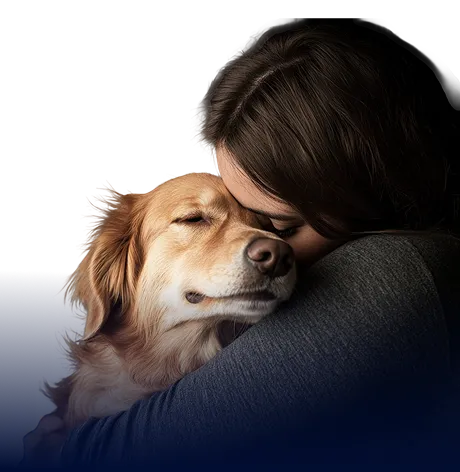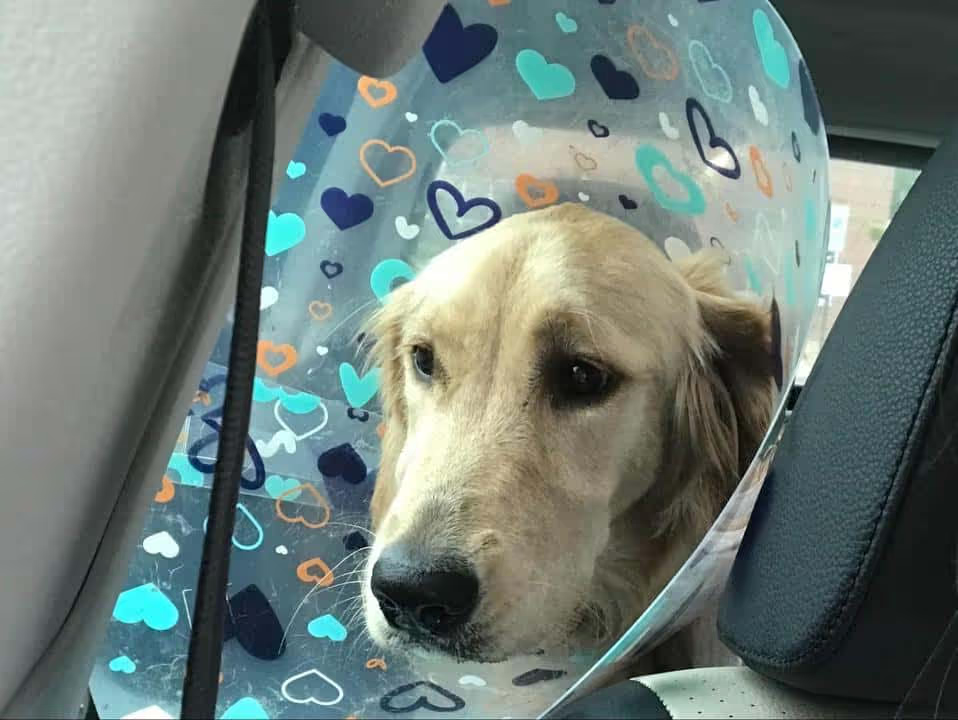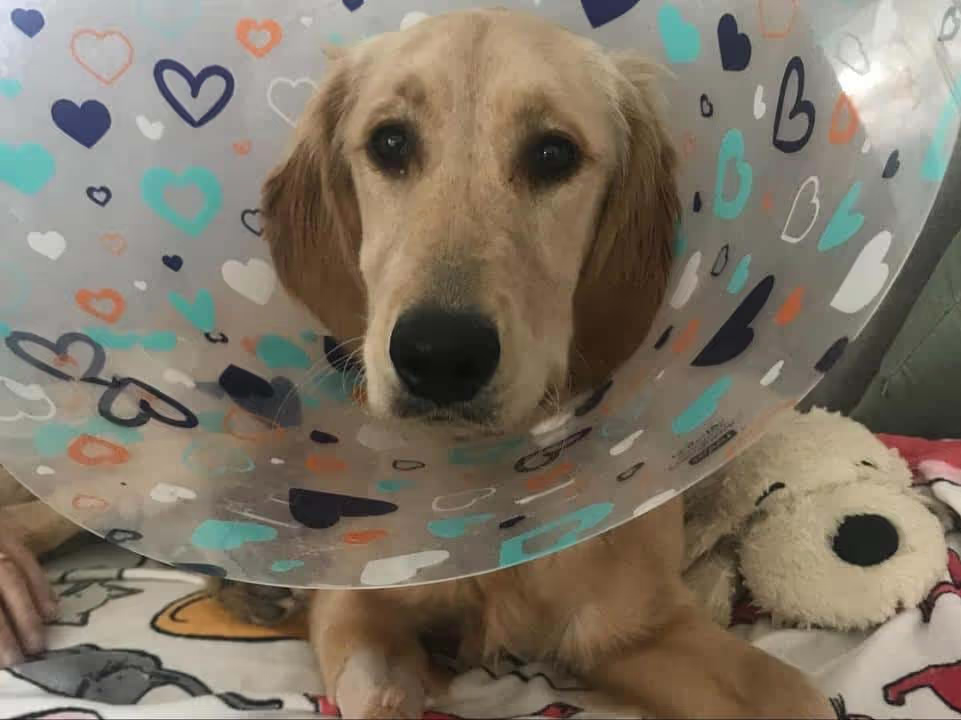For the Purrbabies


When my golden retriever chewed up a suitcase full of clothing, I didn’t know what to do. Here’s what you need to know about intestinal blockages in dogs.

Meet Polly, my very curious Golden Retriever. She joined my family in February of 2021 and quickly taught me the ins and outs of pet parenthood. In September, I brought her with me to the beach for a quick weekend getaway, but that trip ended very differently than normal.
Read on for the story of Polly’s bowel obstruction, and what you need to know about intestinal blockages in dogs.
🚨 Time is crucial. If your dog eats something they shouldn’t, call your vet or visit an animal hospital immediately to treat or avoid an intestinal blockage.
One of the nights we were away, I went out to dinner and came home to chewed-up clothes scattered around my room. Polly had escaped her travel crate and gotten into my luggage. I was hours away from the nearest emergency vet, and I couldn’t tell how much and if she’d eaten anything. So, I did what many new pet parents would do; I waited to see if she’d pass what she had (or hadn’t) eaten.
The next day, Polly seemed like her normal, playful self. She ate breakfast, pooped, and went on her morning walk. She even passed a little bit of fabric, so I thought we were in the clear. In the afternoon we set off on our three-hour drive home. About halfway through the drive, Polly started dry heaving and acting like she needed to throw up. At the time, I didn’t know that this is a major sign of gastrointestinal obstructions in dogs.
When I made it home, Polly was still acting OK and had only thrown up a little bit of phlegm. Sometimes she gets car sick, so I thought I was being an over-worried pet parent.
Polly woke up the next morning vomiting and refusing food and water, which is when I knew she needed help. I called her veterinarian and they confirmed that she was possibly suffering from a bowel obstruction. Polly needed to go to an emergency pet clinic right away. After making a few phone calls to clinics near my home, I immediately drove Polly to a 24/7 animal hospital that specialized in emergency care.
When Polly and I arrived at the animal hospital we waited for almost an hour before she was taken to an exam room. The clinic X-rayed Polly and found foreign material in her stomach and small intestines. They administered IV fluids to see if hydrating her would help her body naturally pass some of the material. Unfortunately, this didn’t help. The clinic decided she needed to have surgery that evening.
The surgeons and veterinarians operated on Polly’s stomach and small intestines to remove the fabric she’d consumed. Polly did well in surgery and the veterinarian called me to report that she was resting and would need to spend a few more days in the clinic to recover. I was so grateful that their team saved Polly’s life.
But, emergency surgeries and overnight stays in a pet hospital are very costly. In fact, at the time, I didn’t have pet insurance. I now believe that pet insurance is 100% worth the cost—and I can’t emphasize that to pet owners enough.

Polly came home with me after spending two more days in the animal hospital. When I picked her up, she immediately perked up and was so happy to be heading home. But there were a few things about post-op care that I wasn’t prepared for: carrying Polly up and down the stairs, keeping her comfortable while wearing a cone, and making sure she didn’t bother her incision.
Plus, at 9 months old, Polly was used to daily walks and playtime, activities that we had to stop until her tummy healed. But, I found that there were other ways to keep her entertained. Polly’s favorite pastime was eating a Kong filled with frozen bananas and dog-safe peanut butter.
Fortunately, she recovered from her operation very well even though her appetite didn’t return for a few days. She was taking lots of medications to keep her comfortable and prevent infection (I found that her pills were easiest to administer when covered in peanut butter). After two weeks, I took Polly to her primary veterinarian for a checkup. They removed her staples and made sure her incision had healed properly.

While Polly’s accident was scary and costly, I learned some important lessons that I hope will prevent this from happening to your dog — or prepare you for what to do in case it does. These are some key lessons I learned from Polly’s intestinal blockage surgery:
I purchased a fabric crate for Polly to use while traveling, like this one, that was light and easy for me to break down. I’d used it countless times with her that summer and had no problems. But Polly learned that she could pull the zipper and escape, which is how I ended up in this situation. If you have a young puppy or curious dog, I highly recommend using a plastic or metal crate, even if it’s heavier or bulkier to bring with you.
👉 Be sure to put in the time to crate train your dog so they feel comfortable in this enclosed space. Check out our guidelines for training puppies and adult dogs to use their crates.
One of the biggest lessons I learned is that you should call your pet’s veterinarian as soon as something happens. While Polly ended up being OK, this story could’ve ended very differently. So, whether your dog accidentally eats a toy or you think they ate toxic food, don’t wait to call a vet for help.
According to our veterinarian, Dr. Michelle Diener, if you’re able to call within two hours of your pet eating a foreign object, the vet may be able to induce vomiting to get the object or toxin to come up. This could prevent your dog from needing surgery or treatment for toxicity.
When dogs eat something they shouldn’t, like fabric, their stomachs are unable to break down and pass the material. This causes the material to get stuck in their stomach or small intestines, which can lead to many problems and even death. I learned that these are the common signs of bowel obstructions in dogs:
Polly had four of these eight symptoms, the most prominent being vomiting and inability to hold any water down. If you suspect that your dog has eaten foreign material, call a veterinarian or emergency pet clinic immediately. Time is of the essence in these scenarios. While eating a foreign material doesn’t always result in emergency surgery, it often does.
Emergency pet care is extremely costly. If your pet needs surgery or has to spend several nights in the hospital, you’ll likely pay thousands of dollars. Pet insurance helps cover owners in the case of an emergency. However, different coverage options will protect your pet in varying scenarios. It’s important to understand what your policy covers.
👉Not sure which provider to use? We researched the best pet insurance companies to help you get started.
No matter how hard we try to keep our fur babies safe, accidents still happen. The best way you can keep your pet safe is by learning what to do in emergencies.
Months later, I’m happy to report that Polly is doing great, and the days of her surgery recovery are far behind us. I now have a metal crate that I use to keep her safe on our adventures together. I hope you never have to go through a similar experience with your pet, but if you do, stay calm and call your pet’s veterinarian for immediate support.
The most obvious sign of a bowel obstruction is that your dog ate something they shouldn’t. If you’re unsure, symptoms of the condition may include persistent vomiting, diarrhea, lethargy, and loss or appetite, among others.
Dogs with obstructions in their gastrointestinal tract will only be able to pass diarrhea because liquid stool is all that will be able to get around the blockage.
Canine bowel obstructions that are left untreated can be fatal, as the symptoms can lead to severe dehydration, loss of appetite, and gas buildup from bloat.
Dogs with intestinal blockages will not eat because of the lack of appetite and nausea from being unable to digest their food properly.
If your dog has a bowel obstruction, you should take them to the nearest animal hospital for emergency veterinary care. Treatment can include inducing vomiting, fluid therapy, and surgery.








